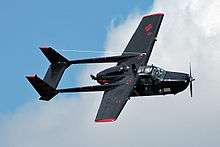Cessna Skymaster
| 336 Skymaster 337 Super Skymaster | |
|---|---|
 | |
| A Cessna 337G Skymaster | |
| Role | Personal use and air taxi aircraft |
| Manufacturer | Cessna Reims Aviation |
| First flight | 1961 |
| Introduction | 1962 |
| Status | Production completed |
| Primary user | Private individuals and organizations |
| Produced | 1963-1982 |
| Number built | 2,993[1] |
| Variants | O-2 Skymaster Conroy Stolifter Spectrum SA-550 |
The Cessna Skymaster is a United States twin-engine civil utility aircraft built in a push-pull configuration. Its engines are mounted in the nose and rear of its pod-style fuselage. Twin booms extend aft of the wings to the vertical stabilizers, with the rear engine between them. The horizontal stabilizer is aft of the pusher propeller, mounted between and connecting the two booms.[1] The combined tractor and pusher engines produce centerline thrust and a unique sound.[2] The Cessna O-2 Skymaster is a military version of the Cessna 337 Super Skymaster.
Development
The first Skymaster, Model 336 Skymaster, had fixed landing gear and initially flew on February 28, 1961.[3][4] It went into production in May 1963[1] with 195 being produced through mid-1964.[2]
In February 1965, Cessna introduced the Model 337 Super Skymaster.[5] The model was larger, and had more powerful engines, retractable landing gear, and a dorsal air scoop for the rear engine. (The "Super" prefix was subsequently dropped from the name.)[2] In 1966, the turbocharged T337 was introduced, and in 1973, the pressurized P337G entered production.[2]
Cessna built 2993 Skymasters of all variants, including 513 military O-2 versions.[1] Production in America ended in 1982, but was continued by Reims in France, with the FTB337 STOL and the military FTMA Milirole.[4]
Design
The Skymaster handles differently from a conventional twin-engine aircraft, primarily in that if an engine fails, the plane will not yaw toward that engine. Without the issue of differential thrust inherent to conventional (engine-on-wing) twins, engine failure on takeoff will not produce yaw from the runway heading. With no one-engine-out minimum controllable speed (Vmc), in-flight control at any flying speed with an engine inoperative is not as critical as it is with engines on the wing with the associated leverage; however, performance in speed and, particularly, rate of climb are affected. Flying a Skymaster requires a pilot to hold a multiengine rating, although many countries issue a special "centerline thrust rating" for the Skymaster and other similarly configured aircraft.[2]
Ground handling requires certain attention and procedures. The rear engine tends to overheat and can quit while taxiing on very hot days.[6] Accidents have occurred when pilots, unaware of the shutdown, have attempted take-off on the nose engine alone, though the single-engine take-off roll exceeded the particular runway length.[7] Federal Aviation Administration Airworthiness Directive 77-08-05 prohibits single-engine take-offs and requires the installation of a placard marked "DO NOT INITIATE SINGLE ENGINE TAKEOFF".[8]
The Skymaster's unique sound is made by its rear pusher propeller slicing through turbulent air from the front propeller and over the airframe while its front tractor propeller addresses undisturbed air.[2]
Operational history
From 1976 until the middle 1990s, the California Department of Forestry and Fire Protection used O-2 variants of the 337 Skymaster as tactical aircraft during firefighting operations. These were replaced with North American OV-10 Broncos, starting in 1993.[9]
Brothers to the Rescue
From 1991 until 2001 the Cuban exile group Hermanos al Rescate (Brothers to the Rescue) used Skymasters, among other aircraft, to fly search and rescue missions over the Florida Straits looking for rafters attempting to cross the straits to defect from Cuba, and when they found them, dropped life-saving supplies to them. Rescues were coordinated with the US Coast Guard, which worked closely with the group. They chose Skymasters because their high wing offered better visibility of the waters below, they were reliable and easy to fly for long-duration missions (averaging 7 hours), and they added a margin of safety with twin-engine centerline thrust. In 1996, two of the Brothers to the Rescue Skymasters were shot down by the Cuban Air Force over international waters. Both aircraft were downed by a MiG-29, while a second jet fighter, a MiG-23 orbited nearby.[10]
Variants
Cessna
- 327 Baby Skymaster - reduced scale four-seat version of the 337, with cantilever wings replacing the 336/337strut-braced configuration. It first flew in December 1967. One prototype was built before the project was cancelled in 1968 due to lack of commercial interest in the design. The prototype was delivered to NASA to serve as a full-scale model for wind tunnel testing. It was used in a joint Langley Research Center and Cessna project on noise reduction and the use of ducted versus free propellers.[11]
- 336 Skymaster - production version powered by two 195 hp (145 kW) Continental IO-360-A engines, 195 built.
- 337 Super Skymaster - 336; retractable undercarriage, redesigned nose cowling and new rear engine intake, and greater wing angle of incidence, powered by two 210 hp (160 kW) Continental IO-360-C engines, 239 built.
- 337A Super Skymaster - 337; minor detail changes, 255 built.
- 337B Super Skymaster - 337A; increased take-off gross weight, optional belly cargo pack, 230 built.
- T337B (1967) Turbo Super Skymaster - 337B; two Continental turbocharged fuel injected 210 hp (160 kW) engines which boosted service ceiling to 33,000 feet (10,000 m), cruise speed to 233 mph (375 km/h), and range to 1,640 miles (2,640 km)
- 337C Super Skymaster - 337B; new instrument panel and increased take-off gross-weight, 223 built.
- 337D Super Skymaster - 337C; minor detail changes, 215 built.
- 337E Super Skymaster - 337D; cambered wingtips and minor changes, 100 built.
- 337F Super Skymaster - 337E; increased take-off gross weight, 114 built.
- 337G Super Skymaster - 337F; split airstair entry door, smaller rear side windows, improved flaps, larger front propeller, powered by Continental IO-360-G engines, 352 built.
- P337G Super Skymaster - 337G; pressurized cabin and turbocharged engines, 292 built.
- 337H Skymaster - 337G; minor changes and optional turbocharged engines, 136 built.
- P337H Pressurized Skymaster - T337G; minor changes, 64 built.
- 337M - US military version designated O-2 Skymaster in service, 513 built.
 Cessna Skymaster O-2
Cessna Skymaster O-2 - O-2A - US military designation of the 337M Forward air control, observation aircraft for the US Air Force. 501 delivered to the USAF and 12 to the Imperial Iranian Air Force[4]
- O-2B: Psychological warfare version for the US Air Force (31 former civil aircraft were converted to O-2B standard).[4]
- O-2T: Twin-turboprop version of O-2, with two 317 hp (236 kW) Allison 250-B15 engines, a longer span wing and improved high lift devices.[12]
- O-2TT: Improved twin turboprop forward air control aircraft, with same wing (43 ft 0 in (13.11 m) wing and engines of O-2T but with new forward fuselage with tandem seating for pilot and observer to give improved view.[4][12]
- Summit Sentry O2-337 : Military version.[3]
- Lynx: Armed military version for the Rhodesian Air Force.
- T337H-SP
Reims Cessna
- F337E Super Skymaster, 24 built.
- F337F Super Skymaster, 31 built.
- F337G Super Skymaster, 29 built.
- FT337G Super Skymaster, 22 built.
- F337H Super Skymaster, 1 built.
- FP337H Pressurized Skymaster, 1 built.
- FTB337G Milirole; military F337G with Sierra Industries Robertson STOL modifications and underwing hardpoints, 61 built.[4]
- Lynx : Rhodesian designation for 21 FTB337Gs delivered to the Rhodesian Air Force.
Conversions/modifications
- AVE Mizar - flying car, created by Advanced Vehicle Engineers, was an attachment of Skymaster wings, tail, and rear engine to a Ford Pinto outfitted with aircraft controls and instruments.[13]
- Conroy Stolifter - an extensive single-turboprop engine STOL cargo plane conversion of the Skymaster. Front engine was replaced with a Garrett AiResearch TPE-331 turboprop; rear engine was removed, and its space filled with an extended cargo pod.
- Groen RevCon 6-X - test conversion of a Cessna 337 Skymaster airplane. This aircraft conversion tested the theory of using fixed-wing airplanes as the basic airframes for gyroplanes to reduce cost and shorten development time.
- Summit Sentry - Summit Aviation of Middletown, Delaware re-manufactured existing used 337 airframes into the militarized O2-337 which includes four wing-mounted NATO standard pylons capable of carrying 350 lb (159 kg) each for 7.62 mm and 12.7 mm gun pods, rocket launchers, bombs, markers and flares. The aircraft was marketed for the target identification and marking, reconnaissance, helicopter escort and aerial photography roles. Examples were sold to the Haitian Air Force, Honduras, Nicaragua, Senegal and the Thai Navy. The variant was still in production in 1987.[3]
- Spectrum SA-550 - built by Spectrum Aircraft Corporation of Van Nuys, California, it was an extensive single-turboprop engine conversion of a Reims FTB337G constructed in the mid 1980s. They removed the nose engine, lengthened the nose, and replaced the rear engine with a turboprop.[14]
Military operators
 Burkina Faso
Burkina Faso - Force Aérienne de Burkina Faso[15]
 Colombia
Colombia- Colombian Air Force[16]
 Mozambique
Mozambique- Força Aérea de Moçambique (3 x FTB-337G) - ex-Portuguese Air Force FTB-337G refurbished and offered by the Government of Portugal to Mozambique in 2011 and 2012.[17]
 Nicaragua
Nicaragua- [18]
 Togo
Togo- Togo Air Force[3]
 Zimbabwe
Zimbabwe- Air Force of Zimbabwe[3]
Former military operators
-
 Bangladesh
Bangladesh - Bangladesh Air Force[19]
-
 Chile
Chile - Chilean Army Three examples, between the end of 1970s and mid-1990s, sold to civilian interests.
-
 Chad[3]
Chad[3] -
 Ecuador[3]
Ecuador[3] -
 El Salvador[3]
El Salvador[3] -
 Equatorial Guinea[20]
Equatorial Guinea[20] -
 Guinea-Bissau
Guinea-Bissau - Força Aérea de Guine-Bissau[21]
-
 Haiti
Haiti - Haitian Air Force[3]
-
 Jamaica[3]
Jamaica[3] -
 Niger
Niger - Military of Niger[18]
-
 Mexico[3]
Mexico[3] -
 Portugal
Portugal - Portuguese Air Force[3] (32 × FTB-337G): Purchased in 1973 to replace the force's aging Dornier Do 27 fleet, which had been used intensively in the Portuguese Colonial War. The first 337 deliveries did not arrive until December 1974—after the end of the war. The last Skymaster in service with the Portuguese Air Force was retired on July 25, 2007.
-
 Sri Lanka
Sri Lanka - Sri Lanka Air Force[3]
Specifications (337D)
Data from Jane's All The World's Aircraft 1969–70[22]
General characteristics
- Crew: one
- Capacity: five passengers
- Length: 29 ft 9 in (9.07 m)
- Wingspan: 38 ft 0 in (11.58 m)
- Height: 9 ft 4 in (2.84 m)
- Wing area: 201 ft² (18.7 m²)
- Empty weight: 2,655 lb (1,204 kg)
- Max. takeoff weight: 4,400 lb (2,000 kg)
- Powerplant: 2 × Continental IO-360-C air-cooled flat-six piston engine, 210 hp (157 kW) each
Performance
- Maximum speed: 199 mph (173 kn, 320 km/h) at sea level
- Cruise speed: 144 mph (125 knots, 232 km/h) at 10,000 ft (3,050 m) (econ cruise)
- Range: 965 mi (839 nmi, 1,553 km)
- Service ceiling: 19,500 ft (5,945 m)
- Rate of climb: 1,200 ft/min (6.1 m/s)
See also
- Related development
- Aircraft of comparable role, configuration and era
References
- 1 2 3 4 Wood, Derek: Jane's World Aircraft Recognition Handbook, page 471. Jane's Publishing Company, 1985. ISBN 0-7106-0343-6
- 1 2 3 4 5 6 Plane and Pilot: 1978 Aircraft Directory, page 92. Werner & Werner Corp Publishing, 1978. ISBN 0-918312-00-0
- 1 2 3 4 5 6 7 8 9 10 11 12 13 Taylor, Michael: Encyclopedia of Modern Military Aircraft; page 67; Gallery Books; 1987; ISBN 0-8317-2808-6
- 1 2 3 4 5 6 Fitzsimons, Bernie: The Defenders - A Comprehensive Guide to the Warplanes of the USA, page 54. Gallery Books, 1988. ISBN 0-8317-2181-2
- ↑ Green, William: Observers Aircraft, page 46. Frederick Warne Publishing, 1974. ISBN 0-7232-1526-X
- ↑ McClellan, J Mac: Adam A500, Flying Magazine pages 52-58. Hachette Filipacchi Media U.S., December 2007. ISSN 0015-4806
- ↑ "NTSB Identification: CEN12FA058, 14 CFR Part 91: General Aviation". NTSB. November 10, 2011.
- ↑ "Airworthiness Directive 77-08-05". Federal Aviation Administration. April 28, 1977. Retrieved 2014-10-24.
- ↑ "CDF aviation management history". State of California. Retrieved 2015-07-04.
- ↑ University of Minnesota Human Rights Library (1999). "Armando Alejandre Jr., Carlos Costa, Mario de la Pena y Pablo Morales v. Republica de Cuba, Case 11.589, Report No. 86/99, OEA/Ser.L/V/II.106 Doc. 3 rev. at 586 (1999)". Retrieved 2007-12-07.
- ↑ Murphy, Daryl (2006). "The Cessnas that got away". Retrieved 2008-12-22.
- 1 2 Taylor 1969, pp. 304–305.
- ↑ Mitzar, Flying Pinto? Archived August 16, 2004, at the Wayback Machine.
- ↑ The Spectrum SA-550
- ↑ Flight International 16–22 November 2004, p. 47.
- ↑ Flight International 16–22 November 2004, p. 52.
- ↑ Mais Alto June 2012, p. 16.
- 1 2 Flight International 16–22 November 2004, p. 77.
- ↑ Flight International 16–22 November 2004, p. 45.
- ↑ Flight International 16–22 November 2004, p. 56.
- ↑ Flight International 16–22 November 2004, p. 62.
- ↑ Taylor 1969, pp. 303–304.
- Taylor, John W. R. Jane's All The World's Aircraft 1969–70. London: Sampson Low, Marston & Company, 1969. ISBN 0-354-00051-9.
- "World Air Forces 2004". Flight International, 16–22 November 2004. pp. 41–100.
External links
| Wikimedia Commons has media related to Cessna 337. |